Tue 25 Dec 2012

Sun 23 Dec 2012
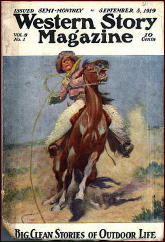
While looking through the Western Story duplicates that I obtained recently, I’ve been involved in that occupation that has driven collectors crazy for generations. Yes, I’m talking about the heartbreaking job of comparing issues to see which copy is the better one. The better condition copy you keep for your own collection and the lesser condition copy eventually finds a new home.
Why did I use the words “crazy” and “heartbreaking” above? Because sometimes the copies have different flaws that make it almost impossible to choose one issue as the “better” one. For instance, many times I’ve compared the two copies of the same issue and seen a small piece out of the cover of one issue; but the other copy has some spine problems or perhaps the pages look white compared to almost white, meanwhile someone has scribbled on the contents page “VG” and maybe the back cover has been bent or maybe, etc, etc, etc.
I’m like the horse caught between two bales of hay; I can’t make a decision and so I starve to death. Or in the case of the collector, you keep both issues!
A while back we were discussing items that we sometimes find inside pulp magazines or comments that a prior owner has written. I’m looking at the June 5, 1920, issue of Western Story and it has a great N.C. Wyeth cover showing a cowboy riding a bucking bronco while two pals cheer him on.
Unfortunately, a prior owner by the name of Frederick Gutzwiller has chosen to scribble on the cover. He has written his full name plus the date of Sunday June 13, 1920. He has even added the time: 1 PM. In addition, he must have reread the issue more than 10 years later, because he has written June 1931 and June 1932. There also is a stamped date of January 1935.
Inside, on the contents page he has written beside some of the stories these dates again. In addition he has rated some of the tales with the comments “poor” and “No Good”. One story he particularly hated because on page 49 where the story “Duty” by S.S. Gordon begins, he has written “29th of June 1932” and slammed it with both “Poor” and “No Good”. But wait, he’s not finished. He then puts on the top of every other page the initials “N.G.”, standing for no good.
Between pages 90 and 91, Mr Gutzwiller, I presume, has tucked a 16 page pamphlet titled, “Cultural Directions for Will’s Pioneer Brand Nursery Stock”. I see the booklet was published in Bismark, North Dakota. At first I had no idea what this booklet was about but upon reading further I found out it all about planting fruits, vegetables, plants, and trees.
I also have pulps where Mr Gutzwiller has listed on the covers the various prices realized for eggs, vegetables, and livestock. What I find so interesting about all this, is that he made these notations more than 80 or 90 years ago and probably is long dead. Yet he lives on with his name prominently displayed on some old magazines for collectors to puzzle over and wonder about. I guess that is a sort of immortality, more than some of us will ever receive.
In fact, as soon as I sign off this computer, I’m going to start writing my name, address, and date on the covers of my pulps. I have a lot, so this might take me quite awhile. I can hardly wait to scribble “Walker Martin” on the set of fine condition Planet Stories that I won at the Frank Robinson auction held by Adventure House.
POSTSCRIPT: Today I’ve spent the whole day continuing to compare issues, which I find to be a lot of fun. There is nothing that make me happier than to look at a fine condition Western Story that I just obtained recently and then see that it is about a dozen times better than my old copy which is sort of brittle and faded, just like me!
Replacing the old, battered copy with the nice condition copy is like being reborn. I feel like a new collector instead of an old one. If I can find hundreds of nice Western Story magazines at this late stage, then what new worlds are waiting to be conquered? Or collected!
Sat 22 Dec 2012
RICHARD BURKE – Murder on High Heels. Gateway, hardcover, 1940; Arrow Mystery Library #5, digest-sized paperback, no date (1943).

Once the thrill, not likely to last even microseconds, has passed from the discovery that the detective’s name is Genghis Donne — his brother’s name is Kublai — which occurs on the second line of Page 1, there isn’t much left of interest here.
Since Clarence Elden, the murdered man, was president of the New York branch of the American Purity League, was owner of a sizable pornography collection, and apparently had a planned assignation with a female for purposes ostensibly impure, Burke could have had some fun with this situation. He doesn’t.
Occasionally I am introduced by mystery authors to others as a “critic.” I respond that actually I am a reviewer. Reviewers appraise, or try to appraise, as in my case, what the author has written; critics tend to deal with what the author would have written if the author had been only half as talented as the critic.
Thus, I am not going to criticize Burke for what he didn’t do in his first novel. I shall merely say that what he did was create, or more accurately borrow, stock characters — among others the dumb and antagonistic cop, the dumb and friendly cop, and the show girl down on her luck — and a plot so forlorn that I kept reading only in the hope that something, anything, fresh might appear. My hope was dashed.
Editorial Comment: Although author Richard Burke wrote nine other mysteries, this was the only appearance of Genghis Donne. (See also Comment #1.)
Fri 21 Dec 2012
THE NEW ADVENTURES OF BEANS BAXTER. Fox, 1987-88. CAST: Jonathan Ward as Benjamin “Beans†Baxter Jr., Jerry Wasserman as Number Two, Stuart Fratkin as Woodshop, Karen Mistal as Cake Lase, Elinor Donahue as Susan Baxter, Kurtwood Smith as Mr. Sue, Scott Bremmer as “Scooter†Baxter, and Rick Lenz as Benjamin Baxter Sr. Theme composed by Joseph Vitarelli, Trumpet solo by Maynard Ferguson. Opening animation by International Rocketship Limited– Marv Newland. Creator/Executive Producer: Savage Steve Holland. Producer: Anthony Eaton.
Recently, I had put on my Indiana Jones hat and went off to explore a land of lost treasures … my storage locker. There I found some ancient Kodak Videotapes, one of which contained three episodes of a forgotten favorite of my past … THE NEW ADVENTURES OF BEANS BAXTER.
It is 1987 and Fox network had just begun. It had placed a lineup that included 21 JUMP STREET and MARRIED WITH CHILDREN on Sunday prime time. The network then turned to Saturday. Originally, Fox had announced its Saturday lineup, that included spy sitcom THE NEW ADVENTURES OF BEANS BAXTER, would premiere May 30 1987, but that was delayed until July (BEANS premiered on July 18, 1987). In the June 8, 1987 issue of “Broadcastingâ€, “FBC†(what the magazine called the Fox network) President James Kellner claimed the reason for the delay was so the network could focus all its promotional efforts on the encouraging ratings of the Sunday lineup.
The original order for BEANS was for thirteen episodes (“Broadcasting†7/13/87). The 8/17/87 issue of “Broadcasting†reported Fox had renewed BEANS and ordered thirteen episodes. While only seventeen episodes were aired, BEANS would remain on the air in reruns from December 1987 until April 1988.
Beans Baxter was a typical 16-year old boy with a sitcom family of a younger brother, Mom and Dad. Dad worked for the Post Office or so the family thought. Dad’s new position forced the family to move from Kansas to Washington D.C. One day Beans sees his Father killed, then learns that his Dad is a spy and still alive. Dad works for the American spy organization called The Network. He had been kidnapped by an evil organization called UGLI. Network’s “Number Two†agrees to let Beans help find and save his Father.
Beans would receive his assignments in ways mocking MISSION: IMPOSSIBLE and GET SMART, from a master of disguise who turns up in such places as a toilet seat cover dispenser in a men’s room stall or the family toaster.
The series was a one-camera sitcom that featured silly, absurdist humor with little concern for reality or deep thought. Creator Savage Steve Holland off beat humor has been featured in such films as BETTER OFF DEAD (85) and animated kid series EEK THE CAT (92).
The cast was believable, a challenge considering the scripts and premise, but beyond that nothing memorable. The opening animation for the theme by Marv Newland (BAMBI MEETS GOZILLA, GARY LARSON’S TALES FROM THE FAR SIDE), and theme music fitted the fun off beat silly mood of the series.
EPISODES WATCHED:

“Beans Runs for President.” (8/1/87) Written and Directed by Savage Steve Holland. Guest Cast: Karen Haber, Taylor Negron, and Adrian Darval *** Beans must interrupt his campaign for High School President to save the daughter of the United States President who had been kidnapped by some angry Clowns.
Silly, brain-dead fun. The daughter is doing something she believes in as she joins an anti-nuclear protest … she believes it is a great place to find a boyfriend. It was 1987 and Clowns were just beginning to become clichés, yet even today the visual humor, such as the group of Circus Clowns armed with machine guns patrolling the hideout, holds up.
Ratings: 3.2
Opposite BEANS was ABC’s Movie CHAPTER TWO (79) repeat: 5.4; CBS’s Movie STILL IN THE NIGHT (82) (rating unknown); and NBC’s 227 repeat: 11.6
“Beans & Satanical Backwards Masking Conspiracy.” (8/8/87) Written and Directed by Savage Steve Holland. GUEST CAST: Dee Snider, Tim Stack and Lorraine Foreman *** Mother approved music is turning teenagers into evil demons lounge lizards who play the accordion. It is all a plot by Mr. Sue and UGLI to take over the World. Can Beans, Dee Snider and rock and roll save the day?
A very funny Exorcist take off with Snider the perfect choice as the music Exorcist.
Ratings: 3.6
Opposite BEANS was ABC’s THE ELLEN BURSTYN SHOW 4.8, CBS’ Movie GUILTY CONSCIENCE (85) repeat 6.8, and NBC’s 227 repeat 12.1
“Beans’ Wicked and Awesome Adventure at College.” (8/15/87) Written and Directed by Savage Steve Holland. Guest Cast: Ian Tracey, Amanda Wyss and Jennifer Stewart *** The Network is after a college student radical in search of information about UGLI. They want Beans to find out if the student radical’s ex-girlfriend and member of a college sorority know where he is.
Cake is tired of Beans ditching her (due to his spy work) while they are on dates, so she decides to follow him. She becomes convinced he is gay. Confusion and misunderstandings cause much of the humor resulting in a weak stupid sitcom episode.
RATINGS: 3.3
Opposite BEANS was ABC’s THE ELLEN BURSTYN SHOW at 3.3, CBS’ Movie CHASE repeat 10.6, and NBC’s 227 repeat 12.7.
So does my old favorite hold up or disappoint? While THE NEW ADVENTURES OF BEANS BAXTER is nothing special, this mash-up of typical mindless 80s sitcom and spy thriller had enough moments to make me hope I have the rest of the episodes on tape somewhere in the forgotten areas of my storage locker. That maybe the only way to see them again as even the collectors market seems to have forgotten this one.
Additional Source: TvTango.com
Thu 20 Dec 2012
WILLIAM HOPSON – Desperado. Century #118, paperback original, 1948. Reprinted as Long Ride To Abilene: Avon #837, paperback, 1958; MacFadden 40-146, paperback, 1964.
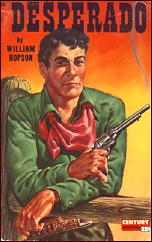
I picked up Desperado by William Hopson because of the cover, and stayed with it because of the text. Hopson was apparently a prolific writer for the pulps (and later for Gold Medal) and his work offers that unique fast prose and hard edge that seem to typify both forms at their best.
The story starts with Jude, a farm boy with wandering feet, who hooks up with a passing cattle drive, makes some friends and helps navigate the outfit to Kansas City. Once there he gets in a shooting scrape on behalf of his employer and when he comes out alive he’s offered a full-time job on the boss’s ranch.
But things around the spread get dicey fast — which is really want you want in a Western, now isn’t it? Jude discovers someone is coming up behind his boss, not just rustling his stock, but worse: eating away at his good name and influence around those parts.
When Jude survives a couple more shooting scrapes and his opponents don’t, he gets a reputation as “that hired gun from Kansas City†and the decent folk and ordinary cowhands shun his company as disreputable or just plain unhealthy. Hence the title, I guess.
Hopson can write. He knows something about ranch life and he can put it across to the reader in a way that conveys all the work and none of the boredom. He handles the action scenes capably, and structures his plot with a pace and economy that’s pretty much lost in these days of mega-books.
I did wonder a bit at how a sod-buster like his hero got so apt with a gun, and the ending softens what might have been a really powerful finish, but these are the conventions of the Western form, and you can’t really fault the author for sticking to them. By and large, it’s a worthwhile book to spend a couple hours with, and one that stays surprisingly in my memory.
Sun 16 Dec 2012
“Not the Running Type.” From Alfred Hitchcock Presents: Season 5, Episode 19. First broadcast: 7 February 1960. Paul Hartman as Milton Potter, Robert Bray as Capt./Lt. Fisher, Bert Freed as Capt. Ellison, Wendell Holmes as Halverson, Herb Ellis as Lt. Hogan, O. Z. Whitehead as Mr. Newton, and Murray Alper as Ship Passenger. Based on a story by Henry Slesar (EQMM, January 1959). Teleplay by Jerry Sohl. Directed by Arthur Hiller.
Capt. Fisher reminisces in a flashback about an old case he was assigned to as a new lieutenant. Milton Potter, a mild-mannered bank employee and just about the last man on earth anyone would suspect of doing such a thing, embezzled $200,000 from a bank 15 years ago.
https://www.youtube.com/watch?v=zzGLFcPDCMs
Not long afterwards, Potter turns himself in, freely admitting that he took the money and still has it. What he won’t do, however, is tell the police where it is. Even after Capt. Ellison and Lt. Fisher offer him leniency if he’ll just cough up the boodle, Potter refuses and goes to prison.
Back in the present, he has just been released — and only now does he tell the authorities where the money is.
The final scene has Potter enjoying himself immensely aboard a cruise ship headed for the South Seas, where he will no doubt benefit from the nearly $200,000 he did NOT steal.
All in all, an entertaining Hitchcock episode with zero violence content.
Henry Slesar (1927-2002) had dozens of his stories adapted for TV and film, including 37 Alfred Hitchcock Presents episodes and 10 for The Alfred Hitchcock Hour.
Sun 16 Dec 2012
ALINA ADAMS – Murder On Ice. Berkley, paperback original; 1st printing, Nov 2003.
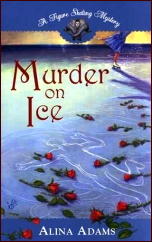
What sport is more open to corruption (in terms of the judging) than figure ice skating? In terms of inside information, there is no one more likely to know than Alina Adams, also known in the real world as figure-skating expert Alina Sivorinovsky.
Here’s a quote from page 3:
And this was all even before the Italian judge turned up dead.
Television sports network 24/7 is there to cover the action, and working for 24/7 as a figure-skating researcher is Rebecca “Bex” Levy, in whose lap falls the task of determining whether Silvana Potenza’s death was an accident, or if the fact that she voted with the Eastern European countries against the skater from the U.S. had something to do with it.
Her investigation is something the skating federation would rather keep under wraps. From page 38, where she is talking to Gil Cahill, her executive producer:
“The more people will plant their eyeballs on all that ISU dirty laundry! Are you kidding me? Those droopy pinkies in the ISU are flaking in their sequined panties about the kind of dirt a real investigation could turn up!”
Politically correct, not. Adams also has a light touch that you could either find very amusing or wince at very easily. From page 114, as Bex’s investigation is starting to gain some headway:
I’m inclined to go with the former — amusing, that is — until the thought struck me, around page 168, that first time authors really should not write nearly 300 page novels the first time they author a book.
Humor is a tough commodity to maintain, in other words, and maybe I ought to be careful myself. The process of solving this case is also a matter of detection by gradual elimination, until there’s only one possibility left, and then Adams keeps you wondering because there is still plenty of book left when this crucial point in time occurs.
Overall, though, this is a better-than-average debut, and I recommend it, leaving open only the question, if this is to be a series (which it is), how many murder investigations in the rather insular world of figure-skating can there be?
The Figure Skating Mystery series —
1. Murder On Ice (2003)
2. On Thin Ice (2004)
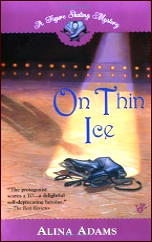
3. Axel of Evil (2006)
4. Death Drop (2006)
5. Skate Crime (2007)
[UPDATE] 12-16-12. So the answer is five, which is more than I would have guessed at the time I wrote this review, and all in all, a pretty good run. For more on the author, including her other, non-mystery work, check out her website here.
Thu 13 Dec 2012
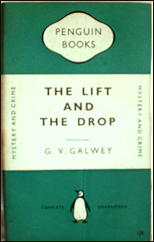
G. V. GALWEY – The Lift and the Drop. Bodley Head, UK, hardcover, 1948. Penguin Books, UK, paperback reprint, 1951.
Since his theory of how to catch a murderer is examining the past of the victim, Chief Inspector “Daddy” Bourne has a real dilemma here. For there were six people in the lift at Pleydell House, home of The Voice and other publications, when it plummeted out of control from the sixth floor to the basement. If any of them were meant to die, which one was it? Or was it an act of mindless terrorism, since no murderer could be certain whom he or she might kill?
A bit too much emphasis on the technical aspects of the murder, a lot too much on the seafaring aspects — I got quite lost as soon as water was approached — a nebulous political scheme, and a murderer with more hubris than I could accept are the weak points here. The strong points are the characters of Bourne and Sergeant Griffiths and their investigation. Well worth reading, and a nimbler mind than mine might find my objections not significant.
The Inspector “Daddy” Bourne series —
Murder on Leave. Lane, 1946.
The Lift and the Drop. Bodley Head, 1948.
Full Fathom Five. Hodder, 1951.
NOTE: These were G. V. Galwey’s only works of mystery fiction. To find out more information about him, check out the Golden Age of Detection wiki here.
Wed 12 Dec 2012
THE MAD DOCTOR. Paramount, 1941. Basil Rathbone, Ellen Drew, John Howard, Barbara Allen (aka Vera Vague), Ralph Morgan, Martin Kosleck, Kitty Kelly. Screenplay by Howard J. Green; cinematography by Ted Tetzlaff; art direction by Hans Dreier & Robert Usher; music score by Victor Young. Director: Tim Whelan. Shown at Cinevent 38, Columbus OH, May 2006.
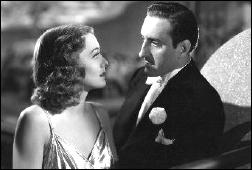
Paramount was not known for its horror films (Universal pretty much had a lock on that genre in this period) but was obviously attempting to capitalize on their popularity with this rather deceptive title, which probably suggests a rather different film than the one its makers had in mind. (It was released in England under the production title, A Date with Destiny.)
In this elegantly directed and produced film, with its black and white cinematography gloriously highlighted in the pristine print, Rathbone, a doctor whose wives have a habit of dying under suspicious circumstances, moves to New York after the death of his third wife arouses the suspicions of a local practitioner (Ralph Morgan) and sets up a Park Avenue practice as a psychiatrist. He effects an apparently miraculous cure for troubled heiress Ellen Drew, with whom he becomes infatuated and whom he makes his fourth wife, an unenviable role as it inevitably turns out.
Rathbone is a smooth, polished villain who is attended by a companion (Martin Kosleck) who is very attentive to his employer’s every need and is clearly more eager to see the quick dispatch of wife number four than Rathbone. Kosleck’s dislike of women is obvious and he dreams of retiring to some foreign country where he and Rathbone can live on the inheritance from Rathbone’s most recent conquest.
Rathbone’s dramatic control contrasts nicely with Kosleck’s tendency toward scarcely contained hysteria. The net result is a rather curious film that could have benefited from some of the panache of the Universal product but impresses nonetheless with its superior production.
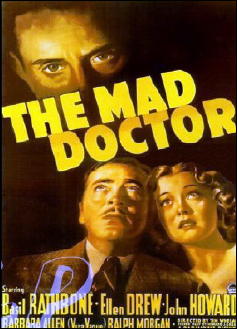
Tue 11 Dec 2012
HI-LIFE. 1998. Campbell Scott, Moira Kelly, Michelle Durning, Eric Stoltz, Peter Rieger, Charles Durning, Katrin Cartlidge, Daryl Hannah. Screenwriter/director: Roger Hedden.
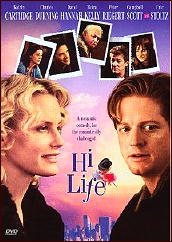
As we approach the Holidays, I want to recommend a Christmas Movie unlike any other: Hi-Life may not seem overtly Capra-esque, but it offers the kind of sardonic/goofy/cynical romanticism that Frank Capra put out for depression-era audiences of the 1930s — minus the tendency toward Capra-corn that marred his best-known films.
Campbell Scott stars as a bartender whose sister (a precise, knowing and humorous performance from Moira Kelley) asks him to raise money — quickly — so she can have an abortion. But—
She’s not really pregnant; her boyfriend (Eric Stoltz) needs the money to pay a gambling debt to his bookie (Charles Durning) But—
She doesn’t know this because Eric told her he needs the money so his sister (Daryl Hannah) can get an abortion. But—
It seems Hannah is an ex-girlfriend who dumped Scott several months ago.
All unaware, Scott wanders Manhattan in one long night a week before Christmas, scouting out old friends who owe him money. He’s followed by Katrin Cartlidge (a fine actress now sadly deceased) as a cute alcoholic who knows his friends will stiff him, but she figures they’ll feel guilty and buy him drinks and if she’s with him she’ll get some.
Meanwhile, Peter Riegert, one of Durning’s (remember him?) hangers-on, has been ordered to stick with Eric Stoltz till he comes back with the money. But—
Seeing a chance for easy profit, Riegert has arranged for the teen-age son of his live-in girlfriend to “mug†them once they get the cash.
Also in the mix are two sub-normal paramedics posing as actors, and the scene where they try to sell the plot of Schindler’s List 2 to Moira Kelley recalls the best of 30s screwball comedy. As does a street fight with an errant boyfriend hiding out disguised as Santa. And the climax, which sees a desperate Eric Stoltz facing his sister and his girlfriend at the same time and trying to convince each that the other one is pregnant. Followed by a sweet ending which sees love and the Christmas Spirit conquer all. With excellent ensemble acting, sharp script and fast direction, Hi-Life may be just the thing to ease those Holiday blues.